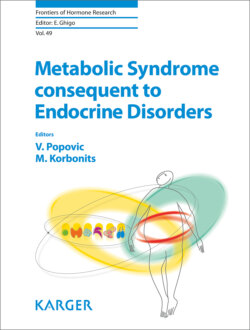Читать книгу Metabolic Syndrome Consequent to Endocrine Disorders - Группа авторов - Страница 21
MetS and Fatty Liver Disease in Patients with GHD and Hypopituitarism
ОглавлениеRecently, several reports have suggested that hepatic impairment and hepatic steatosis may be particularly related to MetS in GHD. Non-alcoholic fatty liver disease (NAFLD) can be diagnosed using imaging techniques while diagnosis of non-alcoholic steato-hepatitis (NASH) is based on histological finding obtained by liver biopsy. NASH is progressive disease characterized by steatosis, inflammatory infiltration, hepatocyte injury, and fibrosis, which can lead to hepatic cirrhosis [3, 81].
Visceral adiposity with insulin resistance and lipid accumulation within hepatocytes, increased oxidative stress, cytokine induction, and inflammation are important for the pathogenesis of the fatty liver disease. Several other factors including (older) age, race, (male) gender, BMI (obesity, especially visceral), and diabetes are known to affect individual susceptibility to NAFLD. Visceral obesity with associated insulin resistance, which are predominant in patients with adult GHD, may play a role in the development of NAFLD irrespective of the BMI value. Direct effects of GH/IGF-1 axis on hepatic metabolism are also important. In mice, GH receptor deletion or post-receptor JAK2 or STAT5 deletion in the hepatocytes results in steatosis and impaired lipid metabolism, while exogenous IGF-1, in the animal model of liver cirrhosis, reduces fibrosis [82–85]. An excess level of glucocorticoid is also associated with the visceral obesity and fatty liver [83].
The study from the USA analyzed prevalence of the MetS and NAFLD in adult (predominantly male) hypopituitary patients [3]. Although the study was controlled for obesity, hypopituitary patients exhibited significantly higher prevalence of hypertension (88 vs. 78%), hypertriglyceridemia (80 vs. 70%), and MetS (90 vs. 71%) [3]. Interestingly, patients with hypopituitarism had significantly higher elevations in serum aminotranspherase levels and hyperbilirubinemia as well as higher INR and hypoalbuminemia consistent with the increased prevalence of liver dysfunction in NAFLD and MetS [3]. High prevalence of abnormal liver function in hypopituitary patients may be strongly affected by endocrine deficiency and its metabolic consequences (insulin resistance, visceral fat accumulation), rather than obesity determined by BMI value [3].
In a Japanese study, prevalence of NAFLD was significantly increased by 6.4-fold in 66 GHD hypopituitary patients compared with the control group [81]. In GHD group serum aminotransferase levels, CRP, and parameters of insulin resistance (IRI and HOMA-IR) were significantly higher than in controls [81]. In GHD patients with NAFLD(+) BMI, visceral fat area, fasting IRI, and HOMA-IR were significantly higher than that in NAFLD(–) GHD patients [81]. HDL cholesterol was lower, while triglycerides and fibrotic marker for the liver type IV collagen were significantly elevated compared to NAFLD(–) GHD group [81]. In 16 (21%) patients with NAFLD, liver biopsy found that 14 had characteristics of NASH [81]. One year of GHRT resulted in significantly decreased aminotranspherase levels and fibrotic markers while, based on histological analysis, steatosis and fibrosis scores in these patients significantly improved [81].
Interestingly gender difference in the prevalence of fatty liver disease (it is much more common in men) was abolished by hypopituitarism and GHD [82]. Fatty liver disease was more common in patients with more severe hypopituitarism, obesity, and MetS and etiology of craniopharyngeoma and non-functioning adenoma compared to other etiologies of hypopituitarism [81].
